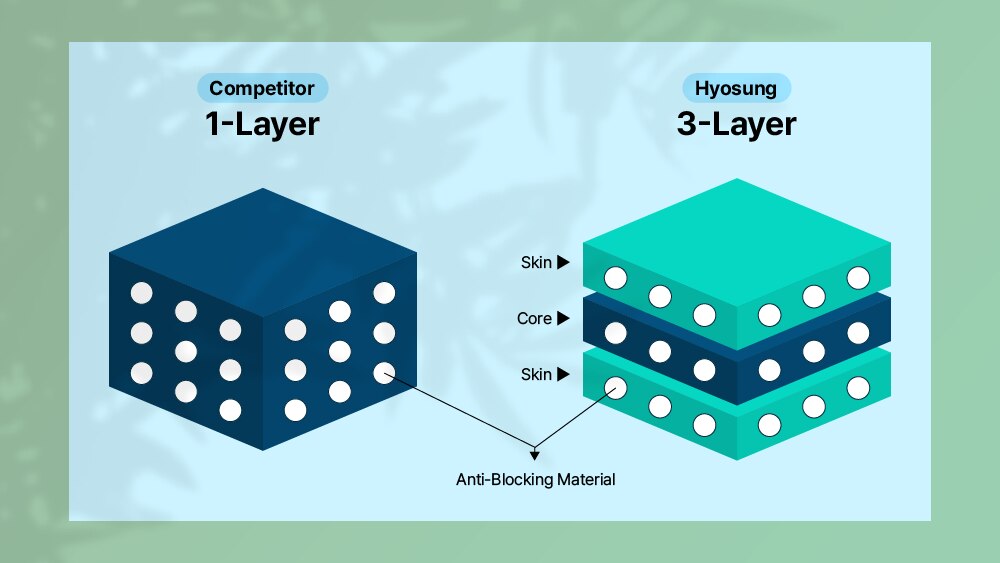Plastics that We Discard, Coming Back as Microplastics?
品牌新闻
Apr 05, 2024
Take a moment to look around us. From disposable cups housing our iced coffee to tumblers, cosmetic cases, children's toys, and electronics, plastics are far more pervasive than we might initially realize. These plastics, deeply ingrained in our lives, seemed to be a universal solution, but they began to reveal their problematic nature after the turn of the 21st century. Everything in our world eventually degrades away and returns to nature, but plastics, which humanity invented for convenience, do not vanish but instead break down into microplastics. The truly concerning issue is the profound impact that these microplastics have on our global ecosystem, including humanity.
Microplastics can be categorized into primary and secondary microplastics. Primary microplastics, known as microbeads, were once added to toothpaste, exfoliants, and even cosmetics. Due to their diminutive size, these particles evade filtration at wastewater treatment facilities, flowing directly into the oceans, disrupting ecosystems, and inevitably circling back to our lives.
According to the World Wildlife Fund's report on 'Assessment of Plastic Ingestion,' an average person consumes about 2000 pieces of microplastics per week. When converted to weight, this equates to ingesting a credit card every week. We can see larger plastic waste like ropes and nets, called megaplastics, or plastic bags and balloons, known as macroplastics. There are even mesoplastics, visible to the eye, ranging from 5mm to 2.5cm in size, but there also exist invisible particles, like microplastics smaller than 5mm and ultra-fine plastics under 1mm. These minuscule plastics infiltrate our bodies, posing the potential to cause central nervous system and thyroid dysfunction, various types of cancers, and detrimental effects on fetal growth and development. The truly grave concern is that the nature of plastic is likely to persist this problem.
The quantity of plastic generated since 2000 matches the cumulative amount produced prior to this date, with 30% of it now flowing back into nature. If this trend persists, it is projected that by 2030, over 100 million tons of plastic will be deposited into our oceans, subsequently re-entering our lives.
To address this issue, the primary step we must take is to cease the usage of plastics, even though this may present immediate challenges. In response, Hyosung Chemical has leveraged its exceptional technological prowess to reduce microplastics and preserve our environment.

Hyosung's PCR PP for "Everyday Plastics"
Various types of plastics serve diverse purposes. PET is utilized for water or beverage bottles; HDPE for shampoo bottles and detergent containers; LDPE for plastic bags and gloves; PVC for leather products, and PS for disposable cutlery and styrofoam. Among these, Polypropylene, commonly known as PP, occupies a significant role in our everyday lives.
Polypropylene, or PP, is used extensively in everyday objects such as cups, straws, and lunch boxes. It boasts exceptional strength, long-lasting durability, and is among the lightest, smoothest, and most transparent of plastics. So, what is unique about the PP produced by Hyosung Chemical?
The key lies in the term: PCR, or Post-Consumer Recycled material, which refers to plastic material created from recycled plastics that end consumers have been used and discarded. Conventionally, plastic production inevitably generate large amounts of carbon from oil extraction to manufacturing. However, recycling discarded plastics offers a dual advantage by utilizing relatively low energy for product production while reducing carbon emissions and waste.
Hyosung Chemical takes this widely-used PP, grinds and cleans it, and re-melts it into pellet form. This process is known as 'mechanical recycling,' and the resulting product is Hyosung Chemical's PCR PP.
Have you ever been to a baseball stadium? The amount of disposable plastic generated while a crowd cheers and enjoys a game is staggering. Hyosung Chemical has launched a pilot project to replace disposable plastic containers used in sports stadiums with reusable containers using PCR PP. Why sports stadiums? While the source of contamination for general plastics can be unclear, making recycling difficult, the contamination source for plastics used in sports stadiums is specific, which makes impurity removal comparatively easier. Furthermore, an additional benefit lies in the production of high-quality PCR PP raw materials, as the plastic waste generated within the sports stadium consists solely of PP.
Hyosung Chemical washes and grinds the collected PP to reproduce it into particles. These are then reprocessed once again into high-purity recycled chips used to manufacture recycled PP raw materials. Only after undergoing this extensive process can a product be considered recycled plastic.

‘Unrecognized Plastic’ Hyosung Chemical's PCR PET Film
When we think of plastic, we often imagine hard objects. However, plastic is used in far more diverse products than we realize. Every day films are no exception. Depending on the material, films can be classified into five main types: Nylon and PP films used mainly for food packaging; PET films used for car tinting and industrial stickers; PE films used for greenhouses and lamination; and PVC films used for floor coverings and industrial packaging. Thus, numerous unrecognized plastic films exist in our daily lives. Considering the threat posed by plastic to our lives, it's only logical that the films around us should also be produced in an environmentally friendly manner. Hyosung Chemical recognizes this.
Hyosung Chemical produces nylon and PET films. Since venturing into the nylon film industry in 1996 and the PET film industry in 1997, Hyosung Chemical has successfully developed proprietary nylon and polyester copolymers as raw materials. This has enabled the production and supply of a diverse range of high-quality film products tailored to meet the specific requirements of customers. Building upon its extensive expertise and technological advancements in the textile material industry, Hyosung Chemical's Film PU division has innovated an environmentally friendly film utilizing PCR PET (PET Bottle Recycle Chip) material. This initiative is driven by the aspiration to positively impact customers' lives, promote a sustainable society, and contribute to environmental preservation.
What is PCR PET? Simply put, it's the recycling of used PET. Various eco-friendly packaging materials have been developed, but Hyosung Chemical sought to go further. Beyond the eco-friendly packaging market, films for mobile device shipment protection and labels are being produced and playing a crucial role deep within our lives. Hyosung Chemical's PCR film utilizes 3 Layer technology, containing over 99% eco-friendly material, and thereby received RCS certification. The RCS certification verifies the recycled material content of the finished product, based on the U.S. Federal Trade Commission's Green Guide, applying the universally recognized principles for recycled products through stringent standards. Hyosung Chemical's PCR film was able to receive RCS certification by including more than 95% recycled material.
In addition to this, Hyosung Chemical is also developing an environmentally friendly silicone film using recycled chips, along with technologies to recycle silicone shape coating products that are typically discarded after use.
Through these various efforts, Hyosung Chemical aims to effectively respond to the environmental regulation of 'recycling more than 50% of plastic packaging waste' by 2025. Moreover, Hyosung Chemical strives to further lead the market by discovering new eco-friendly products and gradually expanding the application fields of PCR PET products to consumer goods, food packaging, and industry.
Leading the trend in the eco-friendly market is the direction Hyosung is striving for.

'A Plastic Harmless to Human Body', Hyosung Chemical's Polyketone
Is recycling plastic instead of discarding it sufficient? Microplastics pose a problem on their own, but they also have the ability to absorb persistent organic pollutants, harmful substances that do not degrade in the natural environment. These pollutants accumulate in plants and animals through the food chain, encompassing the surroundings of our ecosystem. All of this could potentially threaten our health.
What if there existed an alternative to plastic or a safe and non-toxic plastic that poses no harm to the human body? The answer lies in polyketone. Polyketone is characterized by not leaving harmful substances in the body, such as phthalates, formaldehyde, halogens, and heavy metals that are produced by plastics. Numerous domestic and foreign certification organizations have also confirmed it as harmless and safe, including the U.S. Food and Drug Administration (FDA). Moreover, it is superior to nylon by 2.3 times in impact strength, exhibits over 30% greater chemical resistance, remains unaffected by moisture-induced physical changes, and even outperforms polyacetal (POM) in wear resistance by 14 times, making it the preferred choice. It also boasts excellent gas barrier properties and is already used in various industrial applications.
Despite numerous attempts to commercialize this polyketone material, garnering attention as a next-generation engineering plastic, technologically advanced countries like the United States and Japan have faced repeated failures since the 1980s. So, who and how did the currently used polyketone come about? It's Hyosung Chemical.
Starting its research on polyketone in 2004, Hyosung Chemical succeeded in development for the first time in the world in 2014, 10 years later, and secured mass production technology. It also received quality certification from over 150 companies worldwide. In 2016, it received an eco-friendly green certificate from the Ministry of Environment and is being used in everyday utensils, children's toys, and medical parts. Its usage is also continuously expanding, from water meters to vacuum cleaners and automotive parts.
Hyosung's Polyketone Might Just be the Future of Plastic.
Arthur C. Clarke, a science fiction writer and futurist who received the Order of the British Empire, said in his three laws of science, "Any sufficiently advanced technology is indistinguishable from magic." The world has been developing technology focused only on convenience, speed, and efficiency through industrialization. To the people of that era, technology at this level would have seemed nothing short of magic. But things have changed. With Hyosung's groundbreaking technology that feels almost magical, it is now our duty to assume responsibility not only for enhancing the convenience of our customers' daily lives but also for preventing and addressing environmental pollution and safeguarding the well-being of future generations.
Moving ahead, Hyosung Chemical aspires to drive innovation and take the lead in the materials market, striving to create a world where waste generated in our lives is no longer accepted as the norm.